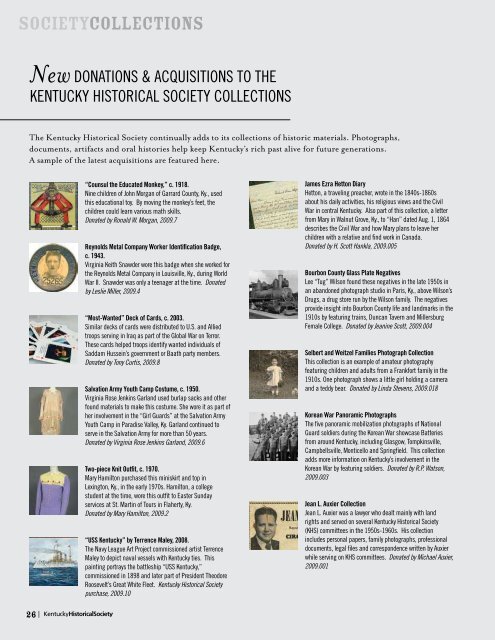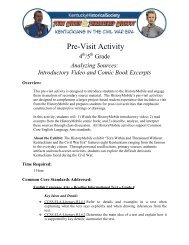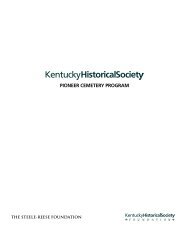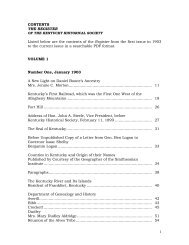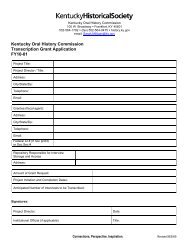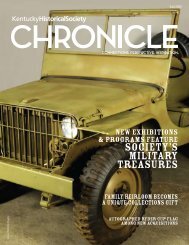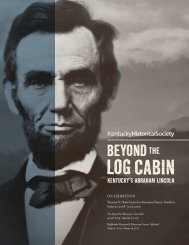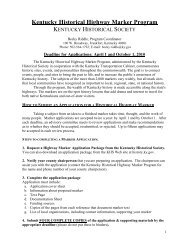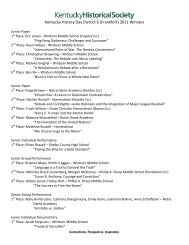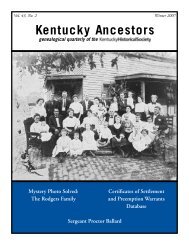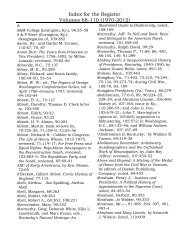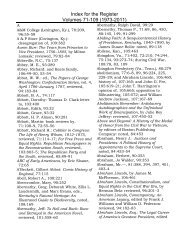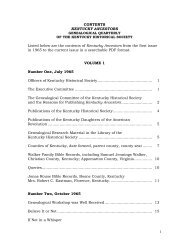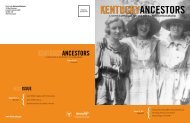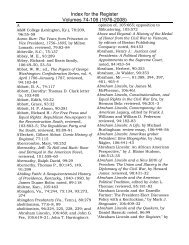kentucky decorative arts treasures - Kentucky Historical Society
kentucky decorative arts treasures - Kentucky Historical Society
kentucky decorative arts treasures - Kentucky Historical Society
Create successful ePaper yourself
Turn your PDF publications into a flip-book with our unique Google optimized e-Paper software.
SOCIETYCOLLECTIONS<br />
New DONATIONS & ACQUISITIONS TO THE<br />
KENTUCKY HISTORICAL SOCIETY COLLECTIONS<br />
The <strong>Kentucky</strong> <strong>Historical</strong> <strong>Society</strong> continually adds to its collections of historic materials. Photographs,<br />
documents, artifacts and oral histories help keep <strong>Kentucky</strong>’s rich past alive for future generations.<br />
A sample of the latest acquisitions are featured here.<br />
“Counsul the Educated Monkey,” c. 1918.<br />
Nine children of John Morgan of Garrard County, Ky., used<br />
this educational toy. By moving the monkey’s feet, the<br />
children could learn various math skills.<br />
Donated by Ronald W. Morgan, 2009.7<br />
Reynolds Metal Company Worker Identification Badge,<br />
c. 1943.<br />
Virginia Keith Snawder wore this badge when she worked for<br />
the Reynolds Metal Company in Louisville, Ky., during World<br />
War II. Snawder was only a teenager at the time. Donated<br />
by Leslie Miller, 2009.4<br />
“Most-Wanted” Deck of Cards, c. 2003.<br />
Similar decks of cards were distributed to U.S. and Allied<br />
troops serving in Iraq as part of the Global War on Terror.<br />
These cards helped troops identify wanted individuals of<br />
Saddam Hussein’s government or Baath party members.<br />
Donated by Tony Curtis, 2009.8<br />
Salvation Army Youth Camp Costume, c. 1950.<br />
Virginia Rose Jenkins Garland used burlap sacks and other<br />
found materials to make this costume. She wore it as part of<br />
her involvement in the “Girl Guards” at the Salvation Army<br />
Youth Camp in Paradise Valley, Ky. Garland continued to<br />
serve in the Salvation Army for more than 50 years.<br />
Donated by Virginia Rose Jenkins Garland, 2009.6<br />
Two-piece Knit Outfit, c. 1970.<br />
Mary Hamilton purchased this miniskirt and top in<br />
Lexington, Ky., in the early 1970s. Hamilton, a college<br />
student at the time, wore this outfit to Easter Sunday<br />
services at St. Martin of Tours in Flaherty, Ky.<br />
Donated by Mary Hamilton, 2009.2<br />
“USS <strong>Kentucky</strong>” by Terrence Maley, 2008.<br />
The Navy League Art Project commissioned artist Terrence<br />
Maley to depict naval vessels with <strong>Kentucky</strong> ties. This<br />
painting portrays the battleship “USS <strong>Kentucky</strong>,”<br />
commissioned in 1898 and later part of President Theodore<br />
Roosevelt’s Great White Fleet. <strong>Kentucky</strong> <strong>Historical</strong> <strong>Society</strong><br />
purchase, 2009.10<br />
James Ezra Hetton Diary<br />
Hetton, a traveling preacher, wrote in the 1840s-1860s<br />
about his daily activities, his religious views and the Civil<br />
War in central <strong>Kentucky</strong>. Also part of this collection, a letter<br />
from Mary in Walnut Grove, Ky., to “Han” dated Aug. 1, 1864<br />
describes the Civil War and how Mary plans to leave her<br />
children with a relative and find work in Canada.<br />
Donated by H. Scott Hankla, 2009.005<br />
Bourbon County Glass Plate Negatives<br />
Lee “Tug” Wilson found these negatives in the late 1950s in<br />
an abandoned photograph studio in Paris, Ky., above Wilson’s<br />
Drugs, a drug store run by the Wilson family. The negatives<br />
provide insight into Bourbon County life and landmarks in the<br />
1910s by featuring trains, Duncan Tavern and Millersburg<br />
Female College. Donated by Jeanine Scott, 2009.004<br />
Selbert and Weitzel Families Photograph Collection<br />
This collection is an example of amateur photography<br />
featuring children and adults from a Frankfort family in the<br />
1910s. One photograph shows a little girl holding a camera<br />
and a teddy bear. Donated by Linda Stevens, 2009.018<br />
Korean War Panoramic Photographs<br />
The five panoramic mobilization photographs of National<br />
Guard soldiers during the Korean War showcase Batteries<br />
from around <strong>Kentucky</strong>, including Glasgow, Tompkinsville,<br />
Campbellsville, Monticello and Springfield. This collection<br />
adds more information on <strong>Kentucky</strong>’s involvement in the<br />
Korean War by featuring soldiers. Donated by R.P. Watson,<br />
2009.003<br />
Jean L. Auxier Collection<br />
Jean L. Auxier was a lawyer who dealt mainly with land<br />
rights and served on several <strong>Kentucky</strong> <strong>Historical</strong> <strong>Society</strong><br />
(KHS) committees in the 1950s-1960s. His collection<br />
includes personal papers, family photographs, professional<br />
documents, legal files and correspondence written by Auxier<br />
while serving on KHS committees. Donated by Michael Auxier,<br />
2009.001<br />
Project Brings Life to “A <strong>Kentucky</strong> Journey”<br />
This spring, the <strong>Kentucky</strong> <strong>Historical</strong> <strong>Society</strong> (KHS)<br />
Interpretive Education team tried something new.<br />
Because of the great size of the Thomas D. Clark<br />
Center for <strong>Kentucky</strong> History’s permanent exhibition—<br />
20,000 feet —visitors sometimes become overwhelmed<br />
and miss many of the unique artifacts and stories<br />
featured in “A <strong>Kentucky</strong> Journey.”<br />
In an attempt to engage students on multiple levels,<br />
the Interpretive Education team along with volunteers<br />
and staff from several other KHS departments,<br />
developed several stations that were placed throughout<br />
“A <strong>Kentucky</strong> Journey.” Students, teachers and<br />
chaperones were encouraged to ask questions and<br />
to discover and experiment with items from past<br />
eras. These stations allowed each guest to take a<br />
personalized <strong>Kentucky</strong> journey, which resulted in a<br />
more memorable experience. By actively engaging<br />
these students, staff and volunteers brought the stories<br />
contained within the exhibition to life.<br />
Another successful season<br />
of the <strong>Kentucky</strong> <strong>Historical</strong><br />
<strong>Society</strong> (KHS) Museum<br />
Theatre Outreach program<br />
has come to a close with<br />
the end of the 2008-2009<br />
school year. The KHS<br />
Museum Theatre team<br />
provided 41 programs<br />
to fourth and fifth grade<br />
students in four <strong>Kentucky</strong><br />
counties.<br />
These “Exploring Perspectives in Frontier <strong>Kentucky</strong>”<br />
workshops combined both social studies and <strong>arts</strong> and<br />
humanities curricula to create an exciting hour of<br />
drama and history for hundreds of elementary school<br />
students. The program was funded through generous<br />
donations from the Lucille Little Foundation and the<br />
CONNECTIONS | Education Briefs<br />
Visitor response to the stations was extremely<br />
enthusiastic. Teachers commented that the time<br />
spent at KHS enhanced their students’ understanding<br />
of the <strong>Kentucky</strong> experience and that the new stations<br />
helped students retain the information that was given<br />
during their visits. KHS staff also enjoyed sharing<br />
their expertise with the 23,000 students, teachers<br />
and chaperones who visited the KHS history campus<br />
last spring.<br />
Students Enjoyed “Exploring Perspectives in Frontier <strong>Kentucky</strong>”<br />
Museum Theatre specialist<br />
Adam Luckey as Daniel Trabue.<br />
late Colonel Armando J. “Al” Alfaro.<br />
Children from Elliott, Fayette, Franklin and Rowan<br />
counties walked in the shoes of frontier families and<br />
Native Americans struggling to understand each other<br />
in early <strong>Kentucky</strong>. Through the workshops, they<br />
learned of the hardships of making the three week<br />
walk into <strong>Kentucky</strong> through the Cumberland Gap,<br />
the fear of being ambushed by Native Americans, and<br />
the experience of building, loading and navigating<br />
flatboats down the Ohio River. They argued over land<br />
ownership and drafted peace treaties. Students created<br />
frozen images of active scenes from the Museum<br />
Theatre play, “Westward into <strong>Kentucky</strong>: The Journal<br />
of Daniel Trabue” and utilized the creative dramatic<br />
skills of pantomime, mimicry and improvisation to<br />
pack bags, saw logs, aim arrows, load muskets and<br />
become dangerous forces of nature such as rainstorms,<br />
pesky insects and river rapids.<br />
26 | www.history.ky.gov |<br />
27


